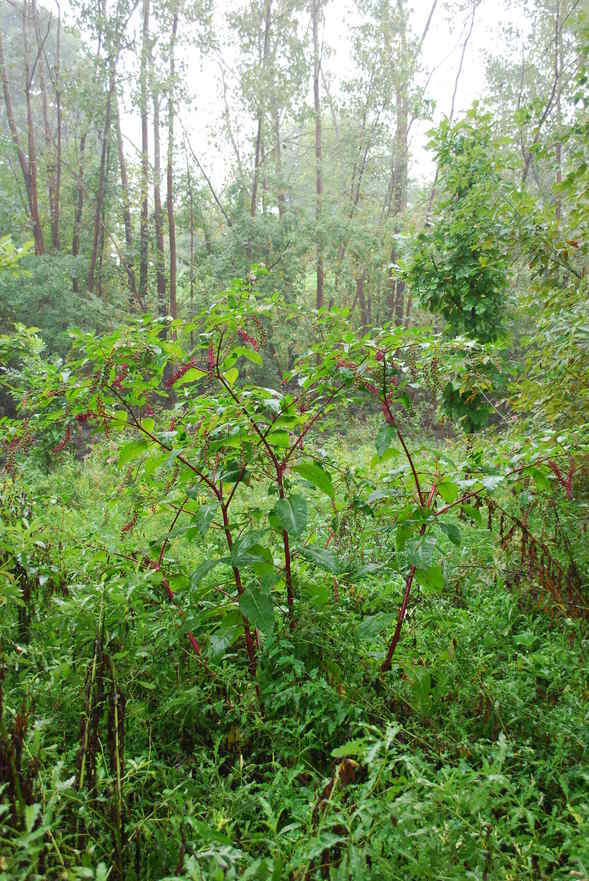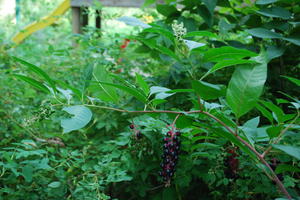Pokeweed - A giant among native plants

A small cluster of Pokeweed plants (Phytolacca americana) gather near Fleming Creek in Parker Mill County Park.
Rick Meader | Contributor
You’re enjoying a nice walk in a rich woods, or along its edge, taking note of the asters and goldenrods starting to bloom, maybe even finding a bundle of bright red Jack-in-the-Pulpit seeds, when, all of a sudden, out of nowhere, you come face to face with a green behemoth. A four to five-foot tall “tree” with large clusters of white flowers, or green or purplish berries or maybe even a purple multi-branched “twig,” it’s unlike any of the other plants you may have seen.
It is pokeweed (Phytolacca americana), and it is a pretty cool plant to have in the right space, for its look and for its attractiveness to birds.
Let’s learn more about it. First, as mentioned before, it’s mainly found in rich, moist woods, or along woodland edges. It is a perennial that is generally between four and five feet tall, but can get taller in the right conditions.
It has a thick, red stalk and its leaves are entire (no teeth or lobes), about three to six inches long and half as wide. When it blooms, the flowers are white in an elongated cluster about three to six inches long. These flowers become flattened berries, starting green and becoming purplish, and the clusters droop below the leaves as they are quite heavy.
Once the seeds are removed from its raceme (cluster of stalks), the purplish red raceme is revealed. It is native to the southern half of Michigan’s lower peninsula, the entire eastern half of North America, and even the Pacific Coast states, according to the USDA Plants Database.
As alluded to before, this is quite a popular plant for birds, which are also responsible for its spread. My long-time birding/gardening consultant, Nancy Meader, reports that robins and cedar waxwings really like the berries, and Annie Reid, in her Nature Notes blog post, says that more than 30 kinds of birds eat them in the fall, and that it was a major food source for the passenger pigeon, now extinct.
As various parts of the plant, including the seeds, are toxic to humans, it’s best to leave them for the birds (although her account also describes a method by which settlers prepared the plant for food). In addition to food, Native Americans used it for a variety of purposes, including treatments for arthritis, rheumatism, eczema and as an analgesic for pain.

The flower cluster (above) and a cluster of berries, waiting to be eaten, on a Pokeweed plant in my backyard.
Rick Meader | Contributor
In terms of landscaping, it is quite an interesting plant to have as a background plant, where its large size and spread would provide a pleasing backdrop for your shorter plants up front, and where it won’t be as unsightly after a good frost, when it crumples to the ground in a misshapen heap. The color provided by the flowers, seeds, and picked over racemes, the life provided by the feasting birds, and the deep green color of the leaves all make it a nice addition, in the right spot with the right soil conditions.
You can wait for a bird to plant it through its natural digestive process, or you can gather some seeds from a plant in the wild and put it where you really want it (local native plant suppliers don’t include it in their plant lists). Due to its toxicity, however, don’t plant them where kids who like to put everything they see in their mouth can get to them. It’s a conversation piece, with a purpose beyond looks.
I also wanted to let you all know about a fun, day-long event going on this Saturday (Sept. 17) at the Kalamazoo Nature Center. "Conservation to Education - Making the Local Connection" will feature workshops and talks about ways people can add to the landscapes they live in and visit (yards, schoolyards, etc.) to make them more attractive and beneficial to butterflies and other pollinators. It is open to the public, but you must pre-register. For more information about this workshop, check out their website: http://www.naturecenter.org/Home/ConservationtoEducation.aspx.
This week, in our little slice of the world: White snakeroot, Bluestem goldenrod, Canada goldenrod, Smooth aster, Calico aster, Arrow-leaved aster, Heart-leaved aster, New England aster, Brown-eyed Susan, Black-eyed Susan,Green-headed coneflower, Pearly everlasting, Ironweed, Bluestem goldenrod, Canada goldenrod, Zig-zag goldenrod, Stiff goldenrod, Tall white lettuce,Tall coreopsis and, of course, Pokeweed. Colorful berries still remaining are Spicebush (not many), Spikenard, Jumpseed, Jack-in-the-Pulpit, False Solomon’s Seal, True Solomon’s Seal and Barren strawberry. Bottlebrush grass, Canada Rye, Big Bluestem and Northern Sea Oats are grasses showing off some pretty seedheads, too.
Get out and enjoy nature everyone, the fall bloomers are starting to show their stuff (but don’t eat the pokeweed berries)!
Rick is a local landscape architect with a special interest in all things natural and creating landscape designs that include a lot of native plants (and the birds and butterflies they support). You can contact him at yourland1824@gmail.com.


Comments
Jackie Byars
Wed, Sep 14, 2011 : 2:01 p.m.
The berries also can be squeezed for a bright pinkish red dye for textiles.